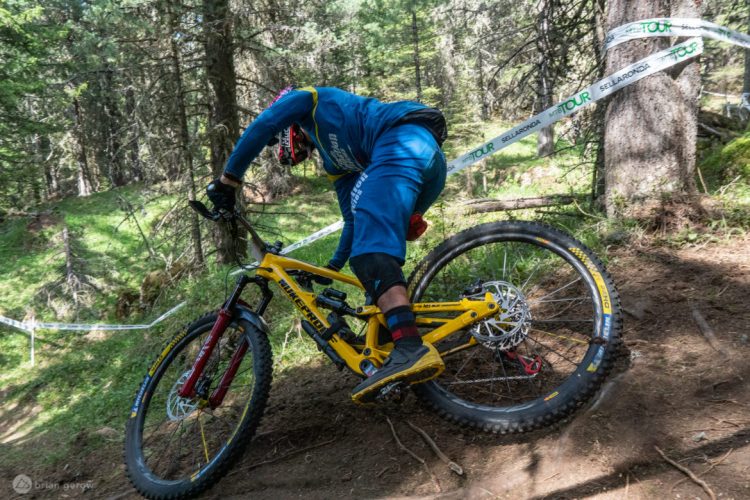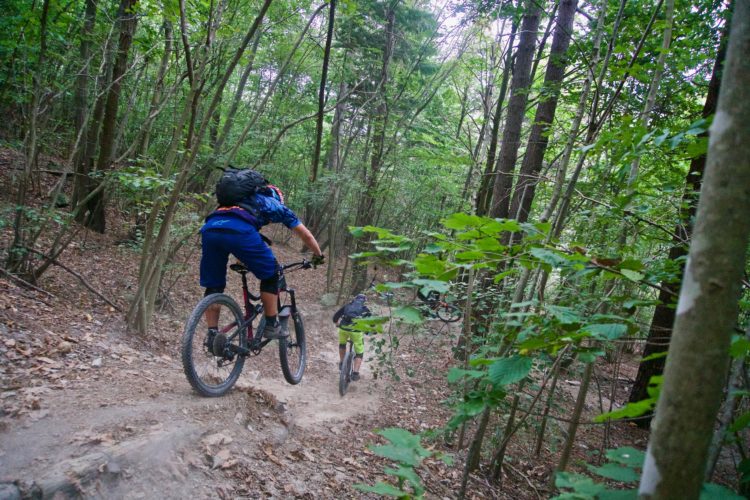
With the dust literally settled, an unpredictable snowstorm dropped into the first Enduro World Series round of 2020 in Zermatt, Switzerland. Following the cancelation and rescheduling of all prior events, a fluffy dusting at the late August premier was a fitting match for the rest of the year’s oddities. The event teetered on cancelation due to safety concerns, and by mid-morning racers finally set off for a two-stage slide down the lower tracks.
The series officials added a race in Pietra Ligure, Italy, between the Zermatt and Finale weekends to give athletes a three-round fight with minimal travel and exposure. Everyone involved with the races had to pass a Covid test and was encouraged to stay in their lodging as much as possible. The race maps were kept private to prevent spectating, and the pits were fenced on all sides. The promoters took every precaution to run a safe event during the pandemic, and they have high hopes that the 2021 series will look more like it has in years past.
EWS Managing Director, Chris Ball, lives in Scotland, where wet weather riding is just riding, and we chatted with him following a morning spin in the slop. Ball started off by sharing some insight into the planning process for 2021. In a recent staff meeting he had posed the question “if we were to start the EWS all over again from scratch, with eight years of experience, what would we do?” The ideas that came out of that roundtable discussion largely focus on offering more races for the athletes, with less travel and associated fuel consumption.
For starters, the professional and amateur races will now be further split up to provide more capacity and a little less time pressure for everyone involved. Additionally, there will now be a “Pro Stage,” similar to the prologue we’ve seen in the past, though this time it will be designed around spectators and broadcasting, with a fixed position on Saturday evenings. There will be series points awarded in the Pro Stage, meaning racers and fans have more numbers to crunch as they factor the season’s overall winners.
A few rounds on the updated series calendar will include double-header races for the pro category, similar to what we saw in the 2020 World Cup downhill races. Instead of a single race day, select venues will include a race on Thursday and a separate race on the following Sunday to provide riders with more chances to earn points. This system will give teams and event locations more bang for their buck, with longer stays in each location and more racing. The split between elite events will also allow athletes in the classic EWS races to double up with the EWS-E events, which a number of professional riders expressed interest in last season.
All of this localized racing focus means that teams can shrink their annual carbon footprint while racing more than before, and saving some cash. For privateer riders, this extended format means that the one or two rounds that they can afford a flight to will have a lot more points available. Ball also mentioned that “weather-wise it protects us a little. We’ve had our fair share of storms, snow, wildfires, and you name it, so to have two races in a week helps secure the worth of everyone’s travel.”

So what about the physical effort of two races in one week? Ball mentioned that a few years ago riders were hitting every track multiple times prior to a race, dialing in every line like a downhill run. Now, riders only get one look at each track, and the rest of their time can be spent resting and exploring the event location. “The physical element has changed a little. Arguably, riders are riding slightly less than they were a few years ago if you include training over the week. So, you’re actually giving the pro riders who do two races five days of back-to-back training and racing. Which, over the course of a week could total 7,000 to 8,000-plus meters of climbing. So you’re right up there with the road, XC marathon, and stage race type numbers. That physical element will really allow us to frame and celebrate the purity of mountain biking as e-bike comes into the fore in the next few years.” Since e-bike races are fast up and down, based on 100% excitement, highlighting the physical challenge of human-powered racing makes a lot of sense.
Finally, the race weekends will be piled back-to-back so athletes can attend a handful of events in one general location, then head home to regroup before returning for the second chunk of competition. It will be a massive physical load, but with proper rest, it should make for an exciting season. “When you actually look at the physicality in comparison to other cycling disciplines, we’re pretty low. The Covid year, with Zermatt, Pietra, and Finale all in a big block allowed us to test a little bit what it’s like racing in close succession. Riders responded really well. It was a good Guinea pig for that. And fans responded really well. We look for routine and consistency in our sport and in our hobbies. We don’t want to wait for a six or seven-week break for that next chapter in the story. So next year [2021] will be two blocks, with a big five-week block at the end of the year. That further helps reduce the environmental load. The southern hemisphere riders and the Americans won’t be coming to Europe five times a year. Maybe they’ll come over twice for bigger trips.”
With high hopes of trackside spectators and no more rescheduled events, the first EWS-E event starts the season off in June. Ball said, “We’re kickin’ off mid-June to give the whole first half of the year over for things to settle post-winter and let spring calm down. It’s a physical calendar and this allows some more preparation for the riders that may be less aerobically conditioned, which is cool.”
Ball says that growing EWS staff continues to be directly connected to racing. “Ruaridh Cunningham joined us at the start of the year as Sports Coordinator. He was full time at the sharp end of racing the year previous, so he has been really good at helping us look at everything from a racer’s perspective.”
We look forward to seeing how the changes the team has created for 2021 play out.
2021 EWS Schedule





















0 Comments